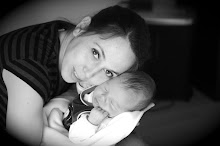Wednesday, July 23, 2008
My baby always has cold hands and feet, why ?
Cold hands and feet are normal at babies, because they can't still regulate 100% blood heat. Cold hands and feet are to be regarded as normal, when the temperature at babies neck is o.k. This will be changing when babys begin to move. Don't care as long as babys hands and feet colour changes into blue.
Sunday, June 15, 2008
May i visit the solarium during lactation ?
You shouldn't use the tanning bed during lactation ,because your skin can discolour by ultraviolet rays. It is also possible due to changed hormonal balance during lactation, your skin gets spotted brown. These discolorations remain possibly always existing. Some women reacts with raw nipples, because the veins of a breastfeeding mother in this time is generally widened.
Baby pushed the head, what should I do?
Take a wet-cold rag or a cooled Coldpack (put it in a cloth) and press it on the pushed place, that prevents dents. Probably the baby will get a small dent or a blue mark. This heals however rather fast. Medical assistance is necessary, if your baby shows any remarkablenesses as following mentioned. For instance shortly unconsciousness, continuously dizzy and affects lethargic or is moaning. A typical alert is also sickness.
How do I find the correct breastfeeding rhythm?
It is best, to breastfeed a baby as required. Most healthy, fully delivered babies even know better, when, how long and how much they must drink at mothers breast.
You can assume that your baby wants to be breastfeeded at least six to eight times in 24 hours. Breastfeed your baby so often and so for a long time it want, also at the night. If your baby becomes older and riper, the number of the quiet breastmeals can become smaller.
Particularly young babies are inclined to a behavior, which is called Clusterfeeding. That means, the baby drinks at certain times frequently and at other times very rarely. The Clusterfeeding episodes arise classicaly in the late afternoon or early evening. Clusterfeeding is not a reference of less breast milk, but it is a really wide-spread quiet behavior with small babies. Clusterfeeding should not be confounded with growth spurts. If your baby wants suddenly clearly more frequently to your chest, this is called growth spurt. Growth spurts are typically in the age from two to three weeks to expect six weeks and three months. Put on your baby simply for a few days more frequently, and the equilibrium between supply and demand will reset itself.
You can assume that your baby wants to be breastfeeded at least six to eight times in 24 hours. Breastfeed your baby so often and so for a long time it want, also at the night. If your baby becomes older and riper, the number of the quiet breastmeals can become smaller.
Particularly young babies are inclined to a behavior, which is called Clusterfeeding. That means, the baby drinks at certain times frequently and at other times very rarely. The Clusterfeeding episodes arise classicaly in the late afternoon or early evening. Clusterfeeding is not a reference of less breast milk, but it is a really wide-spread quiet behavior with small babies. Clusterfeeding should not be confounded with growth spurts. If your baby wants suddenly clearly more frequently to your chest, this is called growth spurt. Growth spurts are typically in the age from two to three weeks to expect six weeks and three months. Put on your baby simply for a few days more frequently, and the equilibrium between supply and demand will reset itself.
How long should I breastfeed my baby ?
According to UNICEF a mother should fully breastfeed her baby 6 months long and afterwards up to the completed 2nd year of life beside baby mash/infant food. Beyond that a mother should breastfeed as long as her child and herself desire.
When is my baby ready for baby mash?
Most babies show a rising readiness for the admission of baby mash between the sixth and ninth life month. Babies are ready for baby mash, if the following points apply:
- the baby shows interest in food and can lead it already to the mouth
- the baby can sit independently
- the baby tongue impact reflex is completely disappeared , that means solid food is not carried out with baby tongue
- the baby shows an increased quiet need of breastfeeding, which doesn't normalize after few days again and is not to due of teething, diseases, stress or growth.
Naturally a baby doesn't have to fulfill all conditions. The experience shows, the more criteria is fulfilled, the beginning of mash feeding succeeds better for both sides .
- the baby shows interest in food and can lead it already to the mouth
- the baby can sit independently
- the baby tongue impact reflex is completely disappeared , that means solid food is not carried out with baby tongue
- the baby shows an increased quiet need of breastfeeding, which doesn't normalize after few days again and is not to due of teething, diseases, stress or growth.
Naturally a baby doesn't have to fulfill all conditions. The experience shows, the more criteria is fulfilled, the beginning of mash feeding succeeds better for both sides .
Subscribe to:
Posts (Atom)
